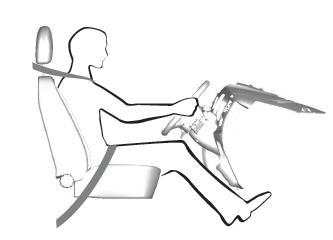Ford Escape: Body Repairs - General Information / Description and Operation - Plastic Repairs
Plastic Components
The following illustration(s) are not all-inclusive of trim levels available. The actual trim level of the vehicle will determine the viability of carrying out a plastics repair. Typically components with moulded-in color or a textured finish are not considered repairable components.
Front Exterior Plastics
.jpg)
| Item | Description | Material |
| 1 | Front upper bumper cover | TPO (Thermoplastic olefin) |
| 2 | Front lower bumper cover | TPO |
| 3 | Front valance panel | TPO |
| 4 | Active cruise control sensor cover | TPO |
| 5 | Front tow hook cover | TPO |
Side Exterior Plastics
.jpg)
| Item | Description | Material |
| 1 | Front wheelhouse opening moulding | TPO (Thermoplastic olefin) |
| 2 | Front door moulding | TPO |
| 3 | Rear door moulding | TPO |
| 4 | Rocker panel moulding | TPO |
| 5 | Rear wheelhouse opening moulding | TPO |
Rear Exterior Plastics
.jpg)
| Item | Description | Material |
| 1 | Rear bumper cover | TPO (Thermoplastic olefin) |
| 2 | Rear spoiler strake | TPO |
| 3 | Rear spoiler | TPO |
| 4 | Rear bumper valance cover | TPO |
Repair Considerations
Several considerations will determine viability of plastic repair procedure(s):
- Is the damage cosmetic or structural?
- Can the repair be carried out on the vehicle?
- Is the part readily available?
- Is component repair the most cost effective method?
- Will the repair provide for the fastest, highest quality repair?
Several types of plastic are in use for automotive application. However, all plastics will fall into 2 primary categories of thermoplastic or thermosetting plastic.
Thermosetting Plastic
Generally, thermosetting plastics are made with 2-part thermosetting resins. When mixed together, heat is generated, producing a cure that is irreversible. Because of this, thermosetting plastics will require the use of a 2-part adhesive for repair.
SMC (Sheet-Molded Composite):
- SMC is a type of thermosetting plastic that uses glass fibers or nylon fibers in combination with thermosetting polyester resins. When fully cured, SMC (Sheet-Molded Composite) is strong and rigid.
- SMC is similar to, but not identical to fiberglass. Ford Motor Company uses SMC (Sheet-Molded Composite) in components such as fenders, hoods and liftgates.
Thermoplastic Compounds
Thermoplastic compounds are manufactured by a process that is reversible. Thermoplastics can be remolded repeatedly by reheating. This characteristic of thermoplastics makes plastic welding a possible repair alternative. A repair of thermoplastic compounds is still possible through the use of a 2-part adhesive and filler repair materials and reinforcements as needed. Thermoplastics are widely used in interior trim components, wheel flares, body side cladding and bumper covers.
Polyolefin
Polyolefins fall into the family of thermoplastics with one unique characteristic: an oily or waxy feel to the material when sanded or ground. Polyolefin lends itself very well to remolding through the use of heat. Because of this, components made of this material lend themselves well to the possibility of plastic welding. Most adhesive repair materials and paint will not bond to the surface of a polyolefin unless an adhesion promoter specially formulated for plastic is first applied to the exposed raw surface. Otherwise, polyolefins are repaired like most other thermoplastics. Polyolefins are used in bumper covers, fan shrouds and wheel housings.
Proper
identification of the various types of plastic is necessary to select
the appropriate repair method(s) to carry out high quality plastic
repairs. For additional information, refer to:
For additional information, refer to: Plastic Repairs (501-25 Body Repairs - General Information, General Procedures).
.
 Description and Operation - Impact of Insufficient Repair Quality
Description and Operation - Impact of Insufficient Repair Quality
Body
repairs usually require a significant level of intervention in the
existing body shell structure. The corrosion protection, seals and NVH components are destroyed and must be replaced...
 Description and Operation - Sealer, Underbody Protection Material and Adhesives
Description and Operation - Sealer, Underbody Protection Material and Adhesives
NOTE:
The following illustrations are examples of structural adhesive and sealer applications and are not all inclusive.
Sealers and Adhesives
The
correct adhesive bonding and sealing is essential to repairing the
vehicle correctly...
Other information:
Ford Escape 2020-2025 Service Manual: Removal and Installation - Fuel Pump and Sender Unit
Special Tool(s) / General Equipment 310-123Locking Ring, Fuel TankTKIT-2004J-FTKIT-2005U-LM Removal WARNING: Do not smoke, carry lighted tobacco or have an open flame of any type when working on or near any fuel-related component...
Ford Escape 2020-2025 Service Manual: Removal and Installation - Rear Door
Special Tool(s) / General Equipment Door Lift Removal NOTE: Removal steps in this procedure may contain installation details. NOTE: LH side shown, RH side similar. Open the door. Remove the rear door check arm bolt...
Categories
- Manuals Home
- 4th Generation Ford Escape Owners Manual
- 4th Generation Ford Escape Service Manual
- Removal and Installation - All-Wheel Drive (AWD) Module - 1.5L EcoBoost (132kW/180PS) – I3 (Y1)/2.0L EcoBoost (177kW/240PS) – MI4
- Power Outlet - Vehicles With: 12V Power Outlet
- Plug-In Hybrid Electric Vehicle Drive Modes
- New on site
- Most important about car
Sitting in the Correct Position

When you use them properly, the seat, head restraint, seatbelt and airbags will provide optimum protection in the event of a crash.
